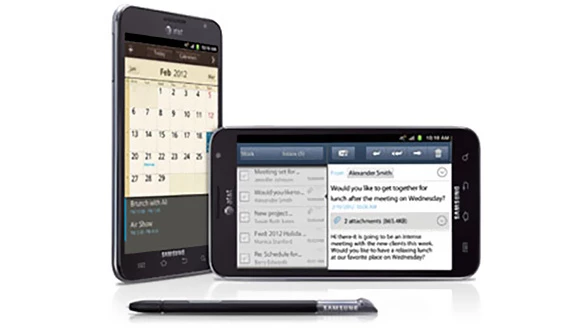Earlier this week, we took a look back at the innovation of the original iPad, five years after the fact. But that got us thinking: what's been the biggest mobile innovation in the five years since then? Take Note: it belongs to Samsung.
We're talking, of course, about big-screened smartphones (phablets, if you will) and the Samsung Galaxy Note. When the original Note launched, in October of 2011, it wasn't just a little bigger than the phones of the day – it absolutely dwarfed them.
Just look at the 5.3-in Galaxy Note (1st generation) next to the most buzzed-about flagship of late 2011, the iPhone 4s (scaled to actual sizes as closely as possible):

The iPhone 4s' screen was only 45 percent as big as the original Note's. Popular handsets like Samsung's own Galaxy S II and Galaxy Nexus, as well as Motorola's Droid Razr, came a little closer, but their display sizes still fell well short of the Note's.
Today flagship smartphone screens typically range from 4.7 inches to 5.5 inches. Their larger phablet counterparts generally start there and sprout all the way up to 6 inches. 2011's "absurdly large" is positively "middle-of-the-road" today.
The original Galaxy Note deserves credit for being ahead of its time, and Samsung should also get kudos for envisioning a future full of PDA-style mobile devices that can serve as both phone and tablet. That also includes the Note's stylus and productivity-based software features. I dug up an old post I wrote from the time that speculated Samsung was aiming the original Note at "business users," and while that may or may not have been the case, its power user focus forecasted the pocket computers that are today's phablets.
That's the world that we live in today – a world that now finally includes Apple – and it's based entirely on an idea that many of us branded as absurd back in late 2011.

The Note's S Pen (stylus) was another innovation of sorts, though it has more asterisks attached to it. For starters, the stylus wasn't exactly a new innovation, as PDAs from years earlier had already covered that ground several times over. Samsung didn't so much create this idea, as much as it brought it back from the dead.
But the bigger asterisk comes from the fact that other smartphone makers haven't put much effort into copying the Note's active stylus input (we've only seen this in niche offerings like the mid-ranged LG G3 Stylus).
Is this because pen input is so synonymous with the Note that everyone else prefers to look for their own angles? Do they perceive the pen as something less than a selling feature? Or does Samsung simply own some patents that are keeping competitors at a distance?
Whatever the reason, the Note's S Pen is a rare kind of smartphone feature: one that adds to the experience of using an extremely popular device and one that has yet to be shamelessly copied by other OEMs. Whenever you see the former, you almost always see the latter – usually within a year or so. But 39 months after the original Note launched, we've yet to see a single high-profile flagship from a competitor that uses active stylus input.

If we're going to give credit to Samsung for starting this large phone trend, though, we're also going to have to rewind a bit and give at least some mention to a glorious failure. You could say that the Dell Streak 5 (above) was the original phablet: in mid-2010, it rocked a 5-in display – which was just as unheard of then as the Note's 5.3-incher was in late 2011.
The Streak was, by all accounts, a turd. And unlike the Note, it was quite the commercial flop as well. Poor screen quality, a thick build and a crappy Dell skin on top of Android 1.6 Donut just didn't make for a great product. But while we're dishing out kudos to the earliest phablets, it's only fair that the failures get some kind of mention.

If there's a lesson to be learned from all of this, perhaps it's to try to keep an open mind when new products seem a little over-the-top and out there. Consumer preferences are like the weather: what's chic today may be laughed at tomorrow, with today's oddball becoming tomorrow's norm. Those of us who, in 2011, were so certain that tiny smartphones sitting next to huge tablets were the "one true path" are looking pretty silly today – as interest in tablets continues to slide, and 4.7-inches now stands as the bare minimum screen size for a flagship smartphone.
One mobile device to rule them all is the order of the day. Who knows what tomorrow will bring?
Like every other modern smartphone-maker, Samsung has benefited from standing on the shoulders of the original iPhone's innovation. But Samsung did innovate in its own right, envisioning a larger multitouch device that harkens back to the long-forgotten PDAs of old. Considering how mercilessly this idea was mocked in the iPhone- and iPad-obsessed world of 2011, it's a testament to Samsung's forward thinking that it followed through (and believed in it enough to invest who-knows-how-much in a 2012 Super Bowl ad that put the Note on the map).






